Pros:
– Sturdy build, feels great in hand
– Certain features are even better than OnePlus 10 Pro
– Qualcomm Snapdragon 8 Gen 2 SoC – as fast as they come
– Excellent QHD+ LTPO3 AMOLED display
– Good main camera performance even in low light
– Capable support cast in photography department
– Good battery backup, charges fully in less than half hour
Cons:
– RIP OxygenOS
– No ingress protection
– Bulky charger, no wireless charging
Rating: 4/5
Price: Rs 56,999 to Rs 61,999
At the start of 2022, a lot of techies and OnePlus fans were excited about what the company would bring to the table in the supposed OnePlus 10; a number that fascinates many. By the end of year, the excitement turned into disappointment as the phone was a no-show. To make matters worse, the OnePlus 10T that the company released towards the end of the year seemed more like a R series phone, thus fueling rumours that the iconic series was on its deathbed.
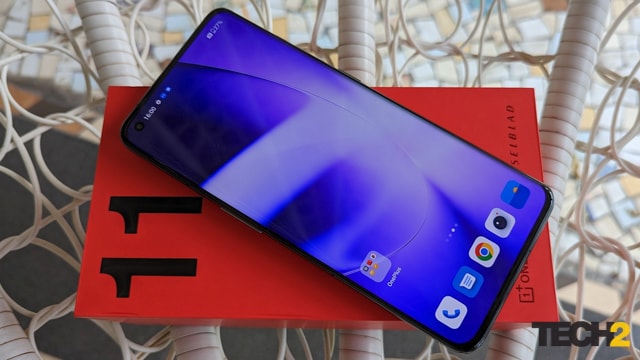
Come 2023, OnePlus put to bed all those rumours with the launch of the OnePlus 11 5G, a fitting representative of the series (non-R/non-Pro). In fact, the new phone is packed with certain features that one would generally associate with the Pro series. So much so that it creates an existential crisis for the OnePlus 10 Pro. After having used the OnePlus 11 5G for over a month, it is time to see if it is indeed worth its not-so-modest asking price and also a better alternative to the 10 Pro.
OnePlus 11 5G Design: Premium build; smart design makes the phone feel compact
The OnePlus 11 5G looks a lot like the 10 Pro with a curved display, slim bezels and a punch-hole at the top left of the screen for the selfie camera. The same applies to the back of the Titan Black variant that we got for review, with a matte glass that is a neat little throwback to the sandstone finish of the first OnePlus phone, and it also remains smudge-free. For the first time since the OnePlus 8T/9R, you get an Aluminium frame on a non-Pro OnePlus device. The frame is a touch glossy here as compared to the matte finish on the 10 Pro.
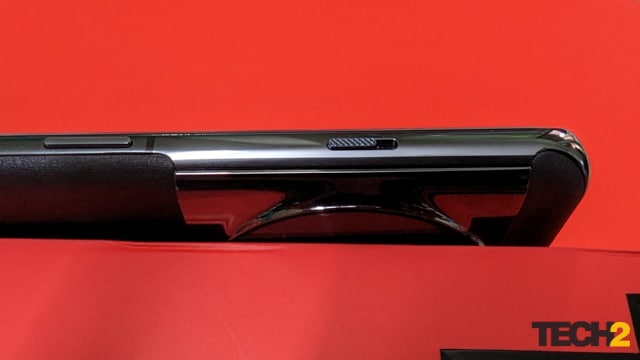
The alert slider is back, which inexplicably went missing on the 10T. While the position of the rear cameras remains similar to the 10 series phones, the squarish camera island now makes way for a circular one on the 11. It is hard to say which one looks better, but neither look bad, so no complaints. It does blend nicely into the frame just like the display. The display is protected by a layer of Corning Gorilla Glass Victus, while the back has Corning Gorilla Glass 5 protection against scratches.
The OnePlus 11 5G is 0.3 mm slimmer than the 10T, but the weight is quite similar, and tilts the scale at 205 grams. I wouldn’t term this phone compact or light, but courtesy of its smart design and even weight distribution, the phone neither feels too big nor too heavy in hand. The volume rockers are placed along the left edge while the power button and alert slider are on the right. A SIM tray, speaker and a USB-C port can be found along the bottom edge. The in-display fingerprint scanner is located a good inch and a half above the bottom edge, which makes it ergonomic.
OnePlus 11 5G Display: Non-Pro goes QHD with a LTPO3 AMOLED display
One of the big changes here is the display, and it’s not just the curved edges I speak of. For the first time ever on a non-Pro OnePlus phone, we have a QHD+ display with a resolution of 3216 x 1440 pixels, as opposed to a Full HD+ screen. That’s similar to what you get on the 10 Pro. The display on both phones has an adaptive refresh rate of 120 Hz, but while the Pro uses a LTPO2 AMOLED display, the OnePlus 11 5G flaunts the new LTPO3 standard with a variable refresh rate ranging from 1 Hz all the way to 120 Hz for better power efficiency.

Both phones have 6.7-inch HDR10+ compliant displays, but the one here offers Dolby Vision compliance too; a welcome addition. The 10-bit display on the OnePlus 11 can get up to 1300 nits bright, and is bright enough even under direct sunlight. You get four screen colour modes – Vivid, Natural, Cinematic and Brilliant, along with a slider for colour temperature adjustment. Natural mode lives up to its name, but if you find the output a tad dull, you can always try Vivid or Brilliant and move the colour temperature slider a bit to the warmer side for good results.
OnePlus 11 5G Performance: As fast as it gets at the moment
OnePlus has opted for the latest and the most powerful Qualcomm SoC around, the Snapdragon 8 Gen 2; the first phone in India with that SoC. You get two variants of the phone here, one with 8 GB LPDDR5 RAM and 128 GB UFS 3.1 storage and the other with 16 GB RAM and 256 GB UFS 4.0 storage. Needless to say, it is blazing fast, and the scores are consistently higher than the Snapdragon 8 Gen 1 chip found in the OnePlus 10T and 10 Pro.
We ran a few synthetic benchmarks to gauge the difference in performance between the OnePlus 11 5G and OnePlus 10 Pro. In Geekbench 5, the 11 5G scored 1079 and 4077 in the single-core and multi-core tests respectively, while the 10 Pro managed to score 968 and 3377 in the respective tests. Thus the Snapdragon 8 Gen 2 chip delivers a 11.5% and 20.7% jump in single-core and multi-core performance respectively, which is impressive. The PCMark Work 3.0 benchmark score was neck and neck with the two phones scoring 10355 and 10374 respectively.
To test the gaming capabilities, we ran the Wild Life and Wild Life Extreme tests from the 3DMark suite, and both phones were too powerful for the Wild Life benchmark and maxed it out. In the Wild Life Extreme benchmark, the OnePlus 11 5G managed to score 3623 with 21.7 average FPS, while the 10 Pro scored 2581 with 15.5 average FPS. That is a massive 40% jump in performance for the Adreno 740 GPU over the Adreno 730, which is mighty impressive. Needless to say, the OnePlus 11 5G managed to run every game we tried on it smoothly without a stutter at the highest setting.
This phone has two speakers, one behind the earpiece and the other at the base of the phone. Collectively they produce a fairly loud sound output with good stereo separation. The phone is Bluetooth 5.3 compliant and has dual-band WiFi with support for a/b/g/n/ac/6/7 standards. We had no reason to complain about the call quality or reception during the course of our testing.
OnePlus 11 5G Battery performance: Good battery life, brisk 100W charging
The battery capacity has seen a slight increment from 4800 mAh on the 10T to 5000 mAh here. It lasts for almost a day and a half of moderate use thanks to the powerful yet power efficient Snapdragon 8 Gen 2 chip. Of course, long hours of gaming will drain the battery faster. But worry not, the bundled 100W charger takes the battery from 1% to 100% in the promised 25 minutes. Charging speed is the only area where its predecessor, the OnePlus 10T has the upper hand, thanks to its 150W SuperVOOC charger.
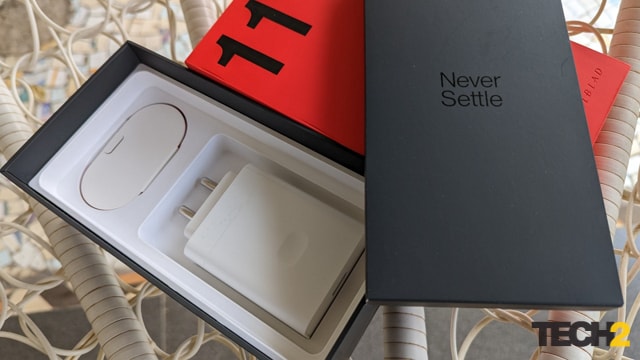
The bundled charger here is relatively slower in comparison and takes 5 additional minutes to charge the OnePlus 11 5G as compared to the 10T, which is perfectly acceptable. Since I had an older 65W OnePlus charger at hand, I tried using that with the 11 too. Interestingly, it takes just 30 minutes to charge this device fully. Now, the bundled 100W charger is quite bulky and heavy, so if you have an older 65W charger lying around, it wouldn’t be a bad idea to use that during travel, leaving the big guy at home.
OnePlus 11 5G Camera performance: Smart choice of rear cameras, very good image quality
You get three cameras at the back of the OnePlus 11 5G, and no, it is not that typically boring 50MP+8MP+2MP combination that the company slapped on most of their phones over the past year or two right from the Nord series to the 10R to even the 10T. The choice of cameras here is far more sensible and versatile; no unnecessary units to fill up marketing sheets. The star of the show is a 50MP primary camera with a Sony IMX890 sensor and optical image stabilisation (OIS).
The second camera is a 48MP ultra-wide shooter based on aSony IMX581 sensor with 115-degrees FOV and auto-focus. This is probably the first time since the OnePlus 7T that auto-focus returns to the ultra-wide camera on a non-Pro OnePlus phone. That lets this camera double up as a macro camera too. And lastly, there is a 32MP telephoto camera with Sony’s IMX709 sensor and 2X optical zoom that can also be used for clicking high quality portrait shots.
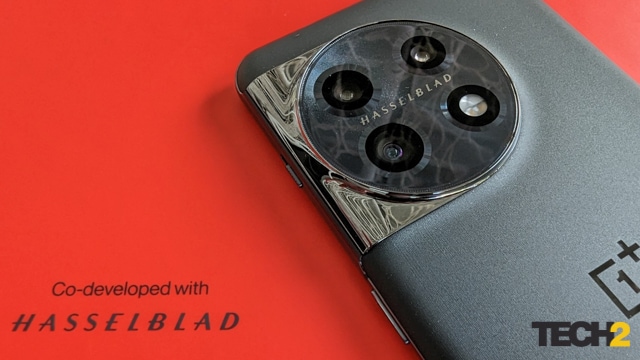
The OnePlus 11 5G benefits from Hasselblad’s colour tuning as well as their expertise in portrait photography. Moving on to image quality, the primary camera clicks some excellent shots with very good detail and impressive dynamic range. Colours are indeed close to natural in most cases, though not as natural as the Google Pixel 7 Pro’s images. The hint of extra saturation is something several users may actually prefer for social media posts.
The low light photography here sees a big improvement over its predecessors, especially on the main camera. It preserves a great amount of detail in low-light captures with minimal noise. Even the colours look natural. When the light drops further, the Night mode kicks in automatically. I quite liked the Night mode here as it makes things just a tad brighter without making the image overly bright, which is the case with several other phones.
The ultra-wide camera is equally impressive in well lit conditions. The colour reproduction and dynamic range are comparable, and the images have a good amount of detail. But as the light drops, the images tend to get softer, and I would suggest switching to the main camera in low light. As I mentioned earlier, the ultra-wide camera has auto-focus, and lets you capture macro shots too. When you get closer to a subject, the phone automatically switches to macro mode.
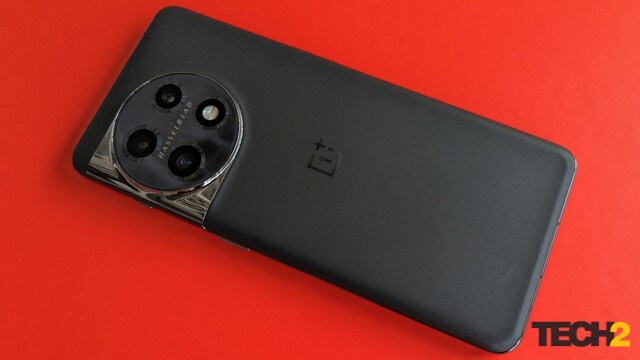
The macro shots can be a hit or a miss as it tends to struggle with the focus at times. So best to click a couple of extra shots in this mode with steady hands. When it focuses right, the captured images are quite good and way better than most ‘dedicated’ 2MP and 5MP macro cameras that you get on several phones. The telephoto camera does a good job, and 2X zoomed shots look sharp enough. Anything beyond 2X is digital zoom and up to 5X zoomed shots are usable. Beyond that they look washed out.
The real purpose of the telephoto camera here is to capture ‘professional grade’ portrait shots, somewhat on the lines of Hasselblad cameras with XCD 30 mm and 65 mm lenses. Yes, the 2X optical zoom is quite handy when capturing portrait shots. Since I haven’t used the above lenses, I cannot compare the results here with what they are capable of, but the portrait shots here are quite impressive, especially with human subjects. It works well with animals too if they stay still long enough, but the edge detection isn’t as smart with other subjects.
The 16MP fixed focus front camera remains unchanged for a while now. It does a decent job with selfies with natural skin tones when the face is well lit. While the front camera is limited to 1080p video recording, the main camera can now record 8K videos at 24 fps. You also have an option for recording 4K videos at 30 and 60 fps, and can go as high as 240 fps for 1080p videos. You get OIS and EIS support to compensate for shaky hands. Best results are obtained with 4K videos and the footage is sharp and stabilised. You get quite a few modes to play with.
Click here for unedited camera samples.
OS and user interface: OxygenOS 13, who?
Don’t get me started! I will try and keep it short. The OnePlus 11 5G runs Android 13 with ColorOS… OK fine, OxygenOS 13, if you say so. When OxygenOS 12 was criticised for having quite a few elements of Oppo’s ColorOS, OnePlus had promised that the next iteration would restore the popular UI’s past glory, but they have clearly gone in the other direction. If OxygenOS 12 had shades of ColorOS, version 13 has sucked the Oxygen out of it completely and is very much ColorOS itself.
If you have never used an older OnePlus phone with OxygenOS 11 or prior, or are willing to let go of the past, OxygenOS 13 is perfectly usable. It remains free of ads and excess bloatware. The UI is smooth, lag-free and fairly easy to comprehend even for a novice. For the fans of the older interface, you can either live with that or live in hope for the coming of ‘the UI that was promised’. The good part being, OnePlus has promised three major Android updates on this phone along with regular security updates over the next few years. That’s more than handy.
Final words: Oh so pro… almost!
The OnePlus 11 5G can be purchased for Rs 56,999 for the 8 GB RAM and 128 GB storage variant and Rs 61,999 for the one with double the RAM and storage, with a one year warranty. That would make it probably the most expensive non-Pro OnePlus phone to date. But then, it is also their most loaded, and does offer certain features that are comparable and some even better than the OnePlus 10 Pro. It does miss out on a couple of features like IP68 rated ingress protection and wireless charging that is available on the Pro, but what you get here far outweighs what you don’t.
You get a phone with the most powerful SoC around, ample RAM and storage with a faster interface, an excellent LTPO3 QHD+ display, good battery backup with fast charging and last but not the least, versatile and competent rear cameras. User interface aside, one can expect OS and security updates for another three years keeping the phone relevant for a lot longer. All things considered, the OnePlus 11 5G is a good all-round phone and easily the best from the company in the past two years. As for alternatives, check this out.
from Firstpost Tech Latest News https://ift.tt/OqhZawQ

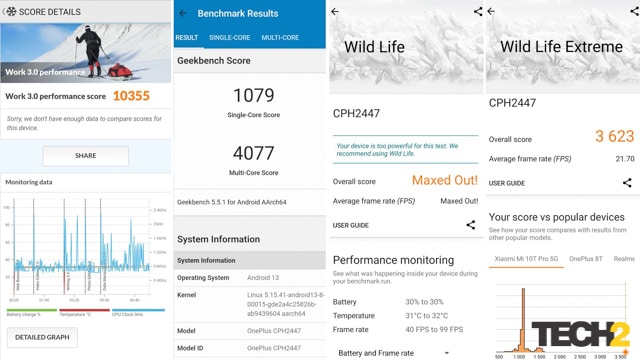
No comments:
Post a Comment
please do not enter any spam link in the comment box.